Configuring Microsoft Windows XP iSCSI Host to MDS/IPS-8
Available Languages
Contents
Introduction
Cisco's iSCSI drivers, which reside on the server, are a key component of the iSCSI solution. These iSCSI drivers intercept SCSI commands, encapsulate them into IP packets, and redirect them to the Cisco SN 5420, Cisco SN 5428, Cisco SN 5428-2, or Cisco MDS/IPS-8. This document provides sample configurations for a host with Microsoft Windows XP iSCSI to MDS/IPS-8.
Prerequisites
Requirements
Before attempting this configuration, ensure that you meet these requirements:
-
Before you create your iSCSI configuration on the MDS 9000, you need to install an iSCSI driver that is compatible to your PC running Microsoft Windows XP. The most current version of the Cisco iSCSI Driver for Windows 2000//XP/2003 can be found on the Cisco iSCSI Drivers (registered customers only) page on Cisco.com. The name of the file is Cisco iSCSI Driver Version version number for Win2k and can be found within the table on this page.
Components Used
The information in this document is based on these software and hardware versions:
-
PC with Microsoft Windows XP and Cisco iSCSI Driver version 3.1.2
-
Cisco MDS 9216 with Software Version 1.1.2
canterbury# show module Mod Ports Module-Type Model Status --- ----- ------------------------------- ------------------ ------------ 1 16 1/2 Gbps FC/Supervisor DS-X9216-K9-SUP active * 2 8 IP Storage Module DS-X9308-SMIP ok Mod Sw Hw World-Wide-Name(s) (WWN) --- ----------- ------ -------------------------------------------------- 1 1.1(2) 1.0 20:01:00:0c:30:6c:24:40 to 20:10:00:0c:30:6c:24:40 2 1.1(2) 0.3 20:41:00:0c:30:6c:24:40 to 20:48:00:0c:30:6c:24:40 Mod MAC-Address(es) Serial-Num --- -------------------------------------- ---------- 1 00-0b-be-f8-7f-08 to 00-0b-be-f8-7f-0c JAB070804QK 2 00-05-30-00-ad-e2 to 00-05-30-00-ad-ee JAB070806SB * this terminal session canterbury# canterbury# show version Cisco Storage Area Networking Operating System (SAN-OS) Software TAC support: http://www.cisco.com/tac Copyright (c) 2002-2003 by Cisco Systems, Inc. All rights reserved. The copyright for certain works contained herein are owned by Andiamo Systems, Inc. and/or other third parties and are used and distributed under license. Software BIOS: version 1.0.7 loader: version 1.0(3a) kickstart: version 1.1(2) system: version 1.1(2) BIOS compile time: 03/20/03 kickstart image file is: bootflash:/k112 kickstart compile time: 7/13/2003 20:00:00 system image file is: bootflash:/s112 system compile time: 7/13/2003 20:00:00 Hardware RAM 963112 kB bootflash: 500736 blocks (block size 512b) slot0: 0 blocks (block size 512b) canterbury uptime is 6 days 1 hours 11 minute(s) 5 second(s) Last reset at 783455 usecs after Thu Aug 28 12:59:37 2003 Reason: Reset Requested by CLI command reload System version: 1.1(2) canterbury#
The information in this document was created from the devices in a specific lab environment. All of the devices used in this document started with a cleared (default) configuration. If your network is live, make sure that you understand the potential impact of any command.
Conventions
The term MDS 9000 refers to any Fibre Channel (FC) switch product in the MDS 9000 family (MDS 9506, MDS 9509, or MDS 9216). IPS blade refers to the IP Storage Services Module.
For more information on document conventions, refer to the Cisco Technical Tips Conventions.
Background Theory
The IP Storage module provides IP hosts access to Fibre Channel (FC) storage devices. The IP Storage module is DS-X9308-SMIP. It provides transparent SCSI routing. IP hosts that use the iSCSI protocol can transparently access SCSI (FCP) targets on the FC network. The IP host sends SCSI commands encapsulated in iSCSI Protocol Data Units (PDUs) to a MDS 9000 IPS port over a TCP/IP connection. On the IP Storage module, connectivity is provided in the form of Gigabit Ethernet (GE) interfaces that are appropriately configured. The IP Storage module enables you to create virtual iSCSI targets and maps them to physical FC targets available in the FC SAN. It presents the FC targets to IP hosts as if the physical targets were locally attached.
Each iSCSI host that requires access to storage by way of the IP Storage module needs to have a compatible iSCSI driver installed. With the iSCSI protocol, the iSCSI driver allows an iSCSI host to transport SCSI requests and responses over an IP network. From the perspective of a host operating system, the iSCSI driver appears to be a SCSI transport driver similar to a FC driver for a peripheral channel in the host. From the perspective of the storage device, each IP host appears as a FC host.
Routing SCSI from the IP host to the FC storage device consists of these main actions:
-
Transporting iSCSI requests and responses over an IP network between hosts and the IP Storage module.
-
Routing SCSI requests and responses between hosts on an IP network and the FC storage device (converting iSCSI to FCP and vice versa). This is performed by the IP Storage module.
-
Transporting FCP requests or responses between the IP Storage module and FC storage devices.
The IP Storage module does not import FC targets to iSCSI by default. Either dynamic or static mapping must be configured before the IP Storage module makes FC targets available to iSCSI initiators. When both are configured, statically mapped FC targets have a configured name. In this configuration, examples of static mapping are provided.
With dynamic mapping, each time that the iSCSI host connects to the IP Storage module, a new FC N port is created, and the nWWNs and pWWNs allocated for this N port may be different. Use the static mapping method if you need to obtain the same nWWNs and pWWNs for the iSCSI host each time it connects to the IP Storage module. Static mapping can be used on the IP Storage module to access intelligent FC storage arrays that have access control and Logical Unit Number (LUN) mapping/masking configuration based on the initiator's pWWNs and/or nWWNs.
You can control access to each statically-mapped iSCSI target if you specify a list of IP Storage ports on which they will be advertised, and specify a list of iSCSI initiator node names allowed to access it. FC zoning-based access control and iSCSI-based access control are the two mechanisms by which access control can be provided for iSCSI. Both methods can be used simultaneously.
iSCSI discovery occurs when an iSCSI host creates an iSCSI discovery session and queries for all iSCSI targets. The IP Storage module returns only the list of iSCSI targets that the iSCSI host is allowed to access based on the access control policies.
iSCSI session creation occurs when an IP host initiates an iSCSI session. The IP Storage module verifies if the specified iSCSI target (in the session login request) is a static mapped target, and if true, verifies that the IP host's iSCSI node name is allowed to access the target. If the IP host does not have access, its login is rejected.
The IP Storage module then creates a FC virtual N port (the N port may already exist) for this IP host, and does a FC name server query for the FCID of the FC target pWWN that is accessed by the IP host. It uses the IP host virtual N port's pWWN as the requester of the name server query. Thus, the name server does a zone-enforced query for the pWWN and responds to the query. If the FCID is returned by the name server, the iSCSI session is accepted. Otherwise, the login request is rejected.
Configure
In this section, you are presented with the information to configure the features described in this document.
Note: To find additional information on the commands used in this document, refer to the Cisco MDS 9000 Family Command Reference, Release 1.2.1a and Cisco MDS 9000 Family Software Configuration Guide, Release 1.2.1a configuration guides.
Note: To find additional information on the commands used in this document, use the Command Lookup Tool (registered customers only) .
Network Diagram
This document uses this network setup:
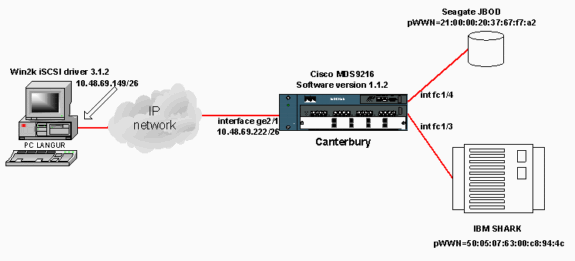
Configurations
This document uses these configurations:
-
Canterbury (MDS 9216)
| Canterbury (MDS 9216) |
|---|
canterbury# sh run Building Configuration ... .... vsan database vsan 601 !--- VSAN 601 has been used for iSCSI targets. .... vsan database vsan 601 interface fc1/3 vsan 601 interface fc1/4 .... boot system bootflash:/s112 boot kickstart bootflash:/k112 ip domain-name cisco.com ip name-server 144.254.10.123 ip default-gateway 10.48.69.129 ip route 10.48.69.149 255.255.255.255 interface GigabitEthernet2/1 ip routing iscsi authentication none iscsi initiator ip-address 10.48.69.149 !--- Identifies the iSCSI initiator based on the IP address. !--- A virtual N port is created for each NIC or network interface. static pWWN 20:03:00:0c:30:6c:24:4c !--- Defining the PC Langur`s pwwn above; this is necessary here since lunmasking is !--- enforced on the IBM Shark, but not on the JBOD. Therefore, pWWN must be statically !--- bound to the initiator to be able to access and manage disks on IBM Shark. vsan 601 !--- VSAN 601 has been used for iSCSI targets. !--- Targets by way of VSAN 601 are accessible by iSCSI initiators. The !--- targets are defined below. Create a static iSCSI virtual target !--- for Seagate JBOD. iscsi virtual-target name san-fc-jbod-1 pWWN 21:00:00:20:37:67:f7:a2 advertise interface GigabitEthernet2/1 initiator ip address 10.48.69.149 permit !--- Create a static iSCSI virtual target for IBM Shark. iscsi virtual-target name shark-c8 pWWN 50:05:07:63:00:c8:94:4c advertise interface GigabitEthernet2/1 initiator ip address 10.48.69.149 permit ... !--- Here, the zone named 'Zone1' is used under VSAN 601 for connectivity. !--- Both initiator and targets are assigned as members of this zone. switchname canterbury zone name Zone1 vsan 601 member pWWN 50:05:07:63:00:c8:94:4c !--- This is IBM Shark. member pWWN 20:03:00:0c:30:6c:24:4c !--- This is PC Langur. member pWWN 21:00:00:20:37:67:f7:a2 !--- This is Seagate JBOD. member symbolic-nodename 10.48.69.149 !--- You have this entry since zone membership is based on pWWN (not on IP address). zoneset name ZoneSet1 vsan 601 member Zone1 zoneset activate name ZoneSet1 vsan 601 .... interface GigabitEthernet2/1 ip address 10.48.69.222 255.255.255.192 iscsi authentication none no shutdown .... interface fc1/3 no shutdown interface fc1/4 no shutdown ... interface mgmt0 ip address 10.48.69.156 255.255.255.192 interface iscsi2/1 no shutdown canterbury# |
Verify
This section provides information you can use to confirm that your configuration is working properly.
Certain show commands are supported by the Output Interpreter Tool (registered customers only) , which allows you to view an analysis of show command output.
On the PC, go to Control Panel and check these items:
-
Network Connections -> Local Area Connection -> TCP/IP properties
-
iSCSI Config -> status of the target (to view a screen capture, see the Displays from PC section of this document).
On the MDS 9216, issue these commands to verify the connectivity:
-
show zone status—displays Zone information.
-
show zone active vsan 601—display zones belonging to the specified VSAN.
-
show fcns database vsan 601—displays Name Server information for a specific VSAN.
-
show fcns database detail vsan 601—displays the local entries for given VSAN.
-
show flogi database vsan 601—displays FLOGI Server information for a specific VSAN.
-
show vsan membership—displays interface information for different VSANs.
-
show iscsi initiator—displays iSCSI initiator information.
-
show iscsi initiator detail—displays iSCSI initiator information in more detail.
-
show iscsi initiator iscsi-session detail—displays detailed information for iSCSI initiator session.
-
show iscsi initiator fcp-session detail—displays detailed information for iSCSI initiator FCP session.
-
show ips stats tcp interface gigabitethernet 2/1 detail—displays TCP statistics for specific GE interface.
-
show iscsi virtual-target configured—displays iSCSI virtual targets that has been configured on the MDS 9000.
-
show iscsi initiator configured—displays iSCSI initiators that have been configured on the MDS 9000.
-
show ips arp interface gigabitethernet 2/1—displays IP Storage ARP information for a specific GE interface.
-
show scsi-target devices vsan 601—displays SCSI devices for specific VSAN (for mapping FC-LUNs to iSCSI-LUNs).
-
show int iscsi 2/1—displays iSCSI interfaces.
-
show iscsi stats iscsi 2/1—displays iSCSI statistics.
-
show int gigabitethernet 2/1—displays GE interface.
-
show ip route—displays IP route information.
-
show ips ip route interface gigabitethernet 2/1—displays the route table.
Troubleshoot
This section provides information you can use to troubleshoot your configuration.
Troubleshoot Procedure
This section provides information you can use to troubleshoot your configuration.
Here is some relevant troubleshooting information for this configuration:
-
Displays from PC
-
Displays from Canterbury Cisco MDS 9216
-
Fabric Manager and Device Manager Displays
Displays from PC
This screen capture is the iSCSI display from PC Langur:
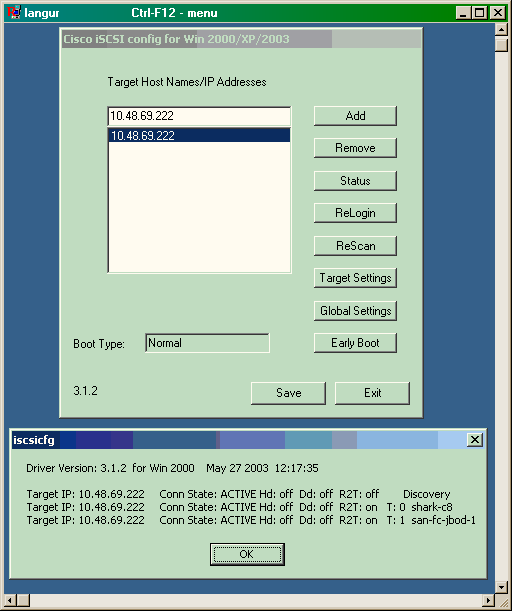
To check these new disks, click on Start in the left lower corner of the PC. Select these options:
My Computer -> Control Panel -> Administrative Tools -> Computer Management
Under System Tools, select Device Manager. On the right side, click on Disk Drives. You should see this:
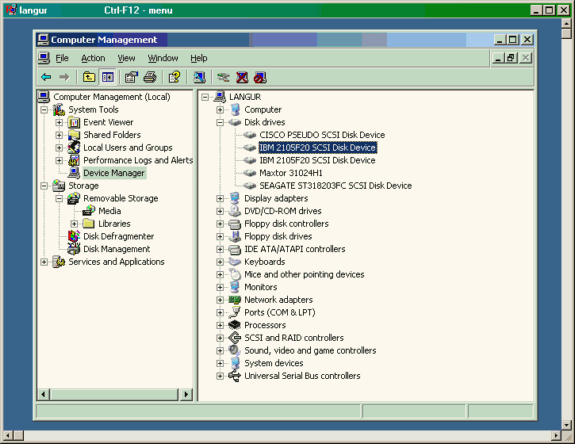
To manage these disks, click on Start in the left lower corner of the PC. Select these options:
My Computer -> Control Panel -> Administrative Tools -> Computer Management
Under Storage , click on Disk Management. The display capture from PC Langur is shown below. Note that Disk1 and Disk2 are from IBM Shark, and Disk3 is the Seagate JBOD.
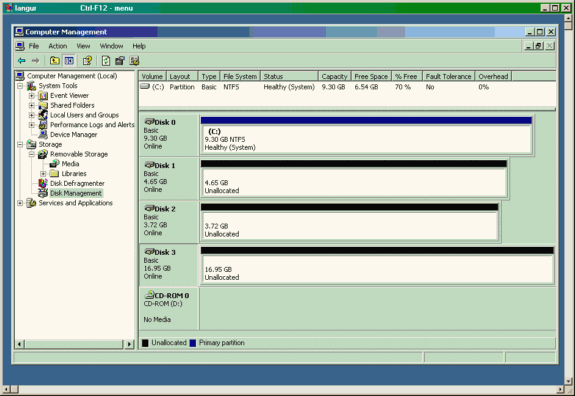
Displays from Canterbury (MDS 9216)
| Displays from Canterbury (MDS 9216) |
|---|
canterbury# show zone status
...
VSAN: 601 default-zone: deny distribute: active only Interop: Off
Full Zoning Database :
Zonesets:1 Zones:1 Aliases: 0
Active Zoning Database :
Name: ZoneSet1 Zonesets:1 Zones:1
Status: Activation completed at Wed Sep 10 09:25:45 2003
...
canterbury#
canterbury# show zone active vsan 601
zone name Zone1 vsan 601
symbolic-nodename 10.48.69.231
* fcid 0x020001 [pWWN 50:05:07:63:00:c8:94:4c]
* fcid 0x020005 [pWWN 20:03:00:0c:30:6c:24:4c]
* fcid 0x0201e8 [pWWN 21:00:00:20:37:67:f7:a2]
* fcid 0x020005 [symbolic-nodename 10.48.69.149]
canterbury#
canterbury# show fcns database vsan 601
VSAN 601:
--------------------------------------------------------------------------
FCID TYPE pWWN (VENDOR) FC4-TYPE:FEATURE
--------------------------------------------------------------------------
0x020001 N 50:05:07:63:00:c8:94:4c (IBM) scsi-fcp:target fc..
0x020005 N 20:03:00:0c:30:6c:24:4c (Cisco) scsi-fcp:init isc..w
0x0201e8 NL 21:00:00:20:37:67:f7:a2 (Seagate) scsi-fcp:target
Total number of entries = 3
canterbury#
canterbury# show fcns database detail vsan 601
------------------------
VSAN:601 FCID:0x020001
------------------------
port-wwn (vendor) :50:05:07:63:00:c8:94:4c (IBM)
node-wwn :50:05:07:63:00:c0:94:4c
class :2,3
node-ip-addr :0.0.0.0
ipa :ff ff ff ff ff ff ff ff
fc4-types:fc4_features:scsi-fcp:target fcsb2-ch-cu fcsb2-cu-ch
symbolic-port-name :
symbolic-node-name :
port-type :N
port-ip-addr :0.0.0.0
fabric-port-wwn :20:03:00:0c:30:6c:24:40
hard-addr :0x000000
------------------------
VSAN:601 FCID:0x020005
------------------------
port-wwn (vendor) :20:03:00:0c:30:6c:24:4c (Cisco)
node-wwn :21:00:00:0c:30:6c:24:42
class :2,3
node-ip-addr :10.48.69.149
ipa :ff ff ff ff ff ff ff ff
fc4-types:fc4_features:scsi-fcp:init iscsi-gw
symbolic-port-name :
symbolic-node-name :10.48.69.149
port-type :N
port-ip-addr :0.0.0.0
fabric-port-wwn :20:41:00:0c:30:6c:24:40
hard-addr :0x000000
------------------------
VSAN:601 FCID:0x0201e8
------------------------
port-wwn (vendor) :21:00:00:20:37:67:f7:a2 (Seagate)
node-wwn :20:00:00:20:37:67:f7:a2
class :3
node-ip-addr :0.0.0.0
ipa :ff ff ff ff ff ff ff ff
fc4-types:fc4_features:scsi-fcp:target
symbolic-port-name :
symbolic-node-name :
port-type :NL
port-ip-addr :0.0.0.0
fabric-port-wwn :20:04:00:0c:30:6c:24:40
hard-addr :0x000000
Total number of entries = 3
canterbury#
canterbury# show flogi database vsan 601
---------------------------------------------------------------------------
INTERFACE VSAN FCID PORT NAME NODE NAME
---------------------------------------------------------------------------
fc1/3 601 0x020001 50:05:07:63:00:c8:94:4c 50:05:07:63:00:c0:94:4c
fc1/4 601 0x0201e8 21:00:00:20:37:67:f7:a2 20:00:00:20:37:67:f7:a2
iscsi2/1 601 0x020005 20:03:00:0c:30:6c:24:4c 21:00:00:0c:30:6c:24:42
Total number of flogi = 3.
canterbury#
canterbury# show vsan membership
...
vsan 601 interfaces:
fc1/3 fc1/4
...
canterbury#
canterbury# show iscsi initiator
...
iSCSI Node name is 10.48.69.149
iSCSI Initiator name: iqn.1987-05.com.cisco:02.e746244830dd.langur
iSCSI alias name: LANGUR
Node WWN is 21:00:00:0c:30:6c:24:42 (dynamic)
Member of vsans: 601
Number of Virtual n_ports: 1
Virtual Port WWN is 20:03:00:0c:30:6c:24:4c (configured)
Interface iSCSI 2/1, Portal group tag: 0x80
VSAN ID 601, FCID 0x020005
canterbury#
canterbury# show iscsi initiator detail
...
iSCSI Node name is 10.48.69.149
iSCSI Initiator name: iqn.1987-05.com.cisco:02.e746244830dd.langur
iSCSI alias name: LANGUR
Node WWN is 21:00:00:0c:30:6c:24:42 (dynamic)
Member of vsans: 601
Number of Virtual n_ports: 1
Virtual Port WWN is 20:03:00:0c:30:6c:24:4c (configured)
Interface iSCSI 2/1, Portal group tag is 0x80
VSAN ID 601, FCID 0x 20005
2 FC sessions, 2 iSCSI sessions
iSCSI session details
Target: shark-c8
Statistics:
PDU: Command: 45, Response: 45
Bytes: TX: 5968, RX: 0
Number of connection: 1
TCP parameters
Local 10.48.69.222:3260, Remote 10.48.69.149:2196
Path MTU: 1500 bytes
Retransmission timeout: 300 ms
Round trip time: Smoothed 219 ms, Variance: 15
Advertized window: Current: 61 KB, Maximum: 62 KB, Scale: 0
Peer receive window: Current: 63 KB, Maximum: 63 KB, Scale: 0
Congestion window: Current: 11 KB
Target: san-fc-jbod-1
Statistics:
PDU: Command: 26, Response: 26
Bytes: TX: 3168, RX: 0
Number of connection: 1
TCP parameters
Local 10.48.69.222:3260, Remote 10.48.69.149:3124
Path MTU: 1500 bytes
Retransmission timeout: 300 ms
Round trip time: Smoothed 219 ms, Variance: 15
Advertized window: Current: 61 KB, Maximum: 62 KB, Scale: 0
Peer receive window: Current: 63 KB, Maximum: 63 KB, Scale: 0
Congestion window: Current: 11 KB
FCP Session details
Target FCID: 0x020001 (S_ID of this session: 0x020005)
pWWN: 50:05:07:63:00:c8:94:4c, nWWN: 50:05:07:63:00:c0:94:4c
Session state: LOGGED_IN
1 iSCSI sessions share this FC session
Target: shark-c8
Negotiated parameters
RcvDataFieldSize 2048 our_RcvDataFieldSize 1392
MaxBurstSize 0, EMPD: FALSE
Random Relative Offset: FALSE, Sequence-in-order: Yes
Statistics:
PDU: Command: 0, Response: 45
Target FCID: 0x0201e8 (S_ID of this session: 0x020005)
pWWN: 21:00:00:20:37:67:f7:a2, nWWN: 20:00:00:20:37:67:f7:a2
Session state: LOGGED_IN
1 iSCSI sessions share this FC session
Target: san-fc-jbod-1
Negotiated parameters
RcvDataFieldSize 1392 our_RcvDataFieldSize 1392
MaxBurstSize 0, EMPD: FALSE
Random Relative Offset: FALSE, Sequence-in-order: Yes
Statistics:
PDU: Command: 0, Response: 26
canterbury# show iscsi initiator iscsi-session detail
iSCSI Node name is 10.48.69.149
iSCSI Initiator name: iqn.1987-05.com.cisco:02.e746244830dd.langur
iSCSI alias name: LANGUR
Node WWN is 21:00:00:0c:30:6c:24:42 (dynamic)
Member of vsans: 601
Number of Virtual n_ports: 1
Virtual Port WWN is 20:03:00:0c:30:6c:24:4c (configured)
Interface iSCSI 2/1, Portal group tag is 0x80
VSAN ID 601, FCID 0x 20005
2 FC sessions, 2 iSCSI sessions
iSCSI session details
Target: shark-c8
Statistics:
PDU: Command: 45, Response: 45
Bytes: TX: 5968, RX: 0
Number of connection: 1
TCP parameters
Local 10.48.69.222:3260, Remote 10.48.69.149:2196
Path MTU: 1500 bytes
Retransmission timeout: 300 ms
Round trip time: Smoothed 217 ms, Variance: 14
Advertized window: Current: 62 KB, Maximum: 62 KB, Scale: 0
Peer receive window: Current: 63 KB, Maximum: 63 KB, Scale: 0
Congestion window: Current: 11 KB
Target: san-fc-jbod-1
Statistics:
PDU: Command: 26, Response: 26
Bytes: TX: 3168, RX: 0
Number of connection: 1
TCP parameters
Local 10.48.69.222:3260, Remote 10.48.69.149:3124
Path MTU: 1500 bytes
Retransmission timeout: 300 ms
Round trip time: Smoothed 217 ms, Variance: 14
Advertized window: Current: 61 KB, Maximum: 62 KB, Scale: 0
Peer receive window: Current: 63 KB, Maximum: 63 KB, Scale: 0
Congestion window: Current: 11 KB
canterbury#
canterbury# show iscsi initiator fcp-session detail
iSCSI Node name is 10.48.69.149
iSCSI Initiator name: iqn.1987-05.com.cisco:02.e746244830dd.langur
iSCSI alias name: LANGUR
Node WWN is 21:00:00:0c:30:6c:24:42 (dynamic)
Member of vsans: 601
Number of Virtual n_ports: 1
Virtual Port WWN is 20:03:00:0c:30:6c:24:4c (configured)
Interface iSCSI 2/1, Portal group tag is 0x80
VSAN ID 601, FCID 0x 20005
2 FC sessions, 2 iSCSI sessions
FCP Session details
Target FCID: 0x020001 (S_ID of this session: 0x020005)
pWWN: 50:05:07:63:00:c8:94:4c, nWWN: 50:05:07:63:00:c0:94:4c
Session state: LOGGED_IN
1 iSCSI sessions share this FC session
Target: shark-c8
Negotiated parameters
RcvDataFieldSize 2048 our_RcvDataFieldSize 1392
MaxBurstSize 0, EMPD: FALSE
Random Relative Offset: FALSE, Sequence-in-order: Yes
Statistics:
PDU: Command: 0, Response: 45
Target FCID: 0x0201e8 (S_ID of this session: 0x020005)
pWWN: 21:00:00:20:37:67:f7:a2, nWWN: 20:00:00:20:37:67:f7:a2
Session state: LOGGED_IN
1 iSCSI sessions share this FC session
Target: san-fc-jbod-1
Negotiated parameters
RcvDataFieldSize 1392 our_RcvDataFieldSize 1392
MaxBurstSize 0, EMPD: FALSE
Random Relative Offset: FALSE, Sequence-in-order: Yes
Statistics:
PDU: Command: 0, Response: 26
canterbury#
canterbury# show ips stats tcp interface gigabitethernet 2/1 detail
TCP Statistics for port GigabitEthernet2/1
TCP send stats
241247690 segments, 176414627280 bytes
239428551 data, 1738205 ack only packets
42541 control (SYN/FIN/RST), 0 probes, 38280 window updates
498 segments retransmitted, 526612 bytes
464 retransmitted while on ethernet send queue, 111295209 packets split
2505024 delayed acks sent
TCP receive stats
34418285 segments, 8983771 data packets in sequence, 9282604852 bytes in s
equence
854523 predicted ack, 6126542 predicted data
0 bad checksum, 0 multi/broadcast, 0 bad offset
0 no memory drops, 0 short segments
1844 duplicate bytes, 77 duplicate packets
0 partial duplicate bytes, 0 partial duplicate packets
123700 out-of-order bytes, 2235 out-of-order packets
6 packet after window, 0 bytes after window
0 packets after close
28128679 acks, 173967225697 ack bytes, 0 ack toomuch, 75348 duplicate acks
0 ack packets left of snd_una, 12 non-4 byte aligned packets
18442549 window updates, 0 window probe
88637 pcb hash miss, 2150 no port, 14 bad SYN, 0 paws drops
TCP Connection Stats
26 attempts, 42272 accepts, 42274 established
42327 closed, 40043 drops, 24 conn drops
106 drop in retransmit timeout, 152 drop in keepalive timeout
0 drop in persist drops, 0 connections drained
TCP Miscellaneous Stats
9776335 segments timed, 9780142 rtt updated
402 retransmit timeout, 457 persist timeout
69188 keepalive timeout, 69015 keepalive probes
TCP SACK Stats
100 recovery episodes, 231520160 data packets, 330107461536 data bytes
396 data packets retransmitted, 482072 data bytes retransmitted
13 connections closed, 46 retransmit timeouts
TCP SYN Cache Stats
42281 entries, 42272 connections completed, 3 entries timed out
0 dropped due to overflow, 6 dropped due to RST
0 dropped due to ICMP unreach, 0 dropped due to bucket overflow
0 abort due to no memory, 43 duplicate SYN, 1833 no-route SYN drop
0 hash collisions, 0 retransmitted
TCP Active Connections
Local Address Remote Address State Send-Q Recv-Q
10.48.69.222:3260 10.48.69.149:1026 ESTABLISH 0 0
10.48.69.222:3260 10.48.69.149:2196 ESTABLISH 0 0
10.48.69.222:3260 10.48.69.149:3124 ESTABLISH 0 0
0.0.0.0:3260 0.0.0.0:0 LISTEN 0 0
canterbury#
canterbury# show iscsi virtual-target configured
target: shark-c8
* Port WWN 50:05:07:63:00:c8:94:4c
!--- The asterisk (*) in front of the pWWN means !--- that you have both discovery and target sessions. If !--- you do not see this, it means that only a discovery !--- session exists.
Configured node
No. of advertised interface: 1
GigabitEthernet 2/1
No. of initiators permitted: 2
initiator 10.48.69.231/32 is permitted
initiator 10.48.69.149/32 is permitted
all initiator permit is disabled
target: san-fc-jbod-1
* Port WWN 21:00:00:20:37:67:f7:a2
Configured node
No. of advertised interface: 1
GigabitEthernet 2/1
No. of initiators permitted: 2
initiator 10.48.69.232/32 is permitted
initiator 10.48.69.149/32 is permitted
all initiator permit is disabled
canterbury#
canterbury# show iscsi initiator configured
...
iSCSI Node name is 10.48.69.149
Member of vsans: 601
No. of pWWN: 1
Port WWN is 20:03:00:0c:30:6c:24:4c
canterbury#
canterbury# show ips arp interface gigabitethernet 2/1
Protocol Address Age (min) Hardware Addr Type Interface
Internet 10.48.69.149 3 0008.e21e.c7bc ARPA GigabitEthernet2/1
Internet 10.48.69.200 0 0008.e21e.c7bc ARPA GigabitEthernet2/1
Internet 10.48.69.201 4 0202.3d30.45c9 ARPA GigabitEthernet2/1
Internet 10.48.69.206 9 0005.9ba6.95ff ARPA GigabitEthernet2/1
Internet 10.48.69.209 6 0009.7c60.561f ARPA GigabitEthernet2/1
Internet 10.48.69.229 4 0800.209e.edab ARPA GigabitEthernet2/1
Internet 10.48.69.233 0 0010.4200.7d5b ARPA GigabitEthernet2/1
Internet 10.48.69.235 0 0800.20b6.6559 ARPA GigabitEthernet2/1
Internet 10.48.69.238 4 0030.6e1b.6f51 ARPA GigabitEthernet2/1
Internet 10.48.69.239 1 0030.6e1c.a00b ARPA GigabitEthernet2/1
Internet 10.48.69.248 7 0202.3d30.45f8 ARPA GigabitEthernet2/1
Internet 10.48.69.252 1 0202.3d30.45fc ARPA GigabitEthernet2/1
Internet 10.10.2.28 0 0202.3d0a.021c ARPA GigabitEthernet2/1
canterbury#
canterbury# show scsi-target devices vsan 601
--------------------------------------------------------------------------------
VSAN FCID pWWN VENDOR MODEL REV
--------------------------------------------------------------------------------
601 0x020001 50:05:07:63:00:c8:94:4c IBM 2105F20 .114
601 0x0201e8 21:00:00:20:37:67:f7:a2 SEAGATE ST318203FC 0004
canterbury#
canterbury# show int iscsi 2/1
iscsi2/1 is up
Hardware is GigabitEthernet
Port WWN is 20:41:00:0c:30:6c:24:40
Admin port mode is ISCSI
Port mode is ISCSI
Speed is 1 Gbps
iSCSI initiator is identified by name
Number of iSCSI session: 3, Number of TCP connection: 3
Configured TCP parameters
Local Port is 3260
PMTU discover is enabled, reset timeout is 3600 sec
Keepalive-timeout is 60 sec
Minimum-retransmit-time is 300 ms
Max-retransmissions 4
Sack is enabled
Maximum allowed bandwidth is 500000 kbps
Minimum available bandwidth is 500000 kbps
Estimated round trip time is 10000 usec
5 minutes input rate 16 bits/sec, 2 bytes/sec, 0 frames/sec
5 minutes output rate 16 bits/sec, 2 bytes/sec, 0 frames/sec
iSCSI statistics
Input 76856 packets, 8696216 bytes
Command 13139 pdus, Data-out 85 pdus, 84292 bytes
Output 89876 packets, 6629892 bytes
Response 13132 pdus (with sense 16), R2T 25 pdus
Data-in 13072 pdus, 2125736 bytes
canterbury#
canterbury# show iscsi stats iscsi 2/1
iscsi2/1
5 minutes input rate 8 bits/sec, 1 bytes/sec, 0 frames/sec
5 minutes output rate 8 bits/sec, 1 bytes/sec, 0 frames/sec
iSCSI statistics
76857 packets input, 8696264 bytes
Command 13139 pdus, Data-out 85 pdus, 84292 bytes, 0 fragments
output 89877 packets, 6629940 bytes
Response 13132 pdus (with sense 16), R2T 25 pdus
Data-in 13072 pdus, 2125736 bytes
canterbury#
canterbury# show interface gigabitethernet 2/1
GigabitEthernet2/1 is up
Hardware is GigabitEthernet, address is 0005.3000.ade6
Internet address is 10.48.69.222/26
MTU 1500 bytes
Port mode is IPS
Speed is 1 Gbps
Beacon is turned off
Auto-Negotiation is turned on
iSCSI authentication: NONE
5 minutes input rate 464 bits/sec, 58 bytes/sec, 0 frames/sec
5 minutes output rate 64 bits/sec, 8 bytes/sec, 0 frames/sec
30544982 packets input, 9266250283 bytes
29435 multicast frames, 0 compressed
0 input errors, 0 frame, 0 overrun 0 fifo
233947842 packets output, 179379369852 bytes, 0 underruns
0 output errors, 0 collisions, 0 fifo
0 carrier errors
canterbury#
canterbury# show ip route
Codes: C - connected, S - static
Gateway of last resort is 10.48.69.129
S 10.48.69.149, gigabitethernet2-1
C 6.6.6.0/30 is directly connected, gigabitethernet2-6
C 5.5.5.0/30 is directly connected, gigabitethernet2-5
C 10.48.69.192/26 is directly connected, gigabitethernet2-1
C 10.48.69.128/26 is directly connected, mgmt0
canterbury#
canterbury# show ips ip route interface gigabitethernet 2/1
Codes: C - connected, S - static
No default gateway
S 10.48.69.149/32 via 0.0.0.0, GigabitEthernet2/1
C 10.48.69.192/26 is directly connected, GigabitEthernet2/1
canterbury# |
Fabric Manager and Device Manager Displays
This section provides screen captures from MDS Fabric Manager 1.1(2) and Device Manager 1.1.(2).
Topology Diagram from the Fabric Manager
This screen capture is the topology diagram from the Fabric Manager:
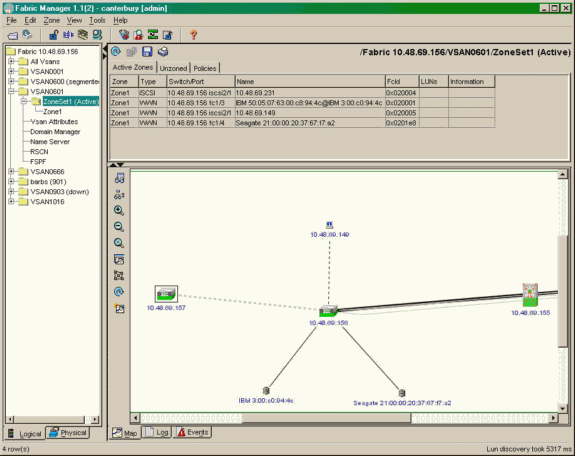
Select FC-LUNs to display the pWWNs, LUN IDs, and capacity of your LUNs from the Device Manager.
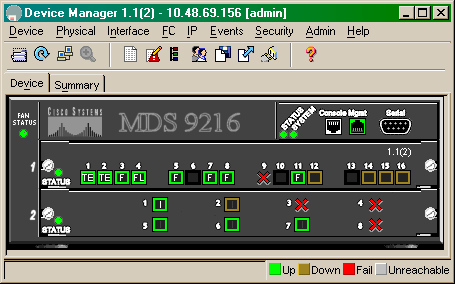
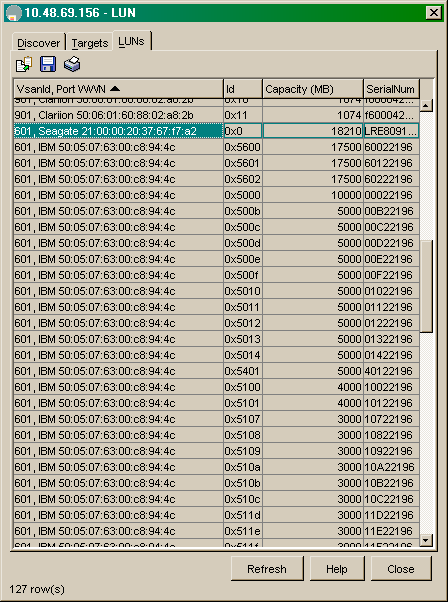
Select IP-iSCSI to display the iSCSI sessions from Device Manager.
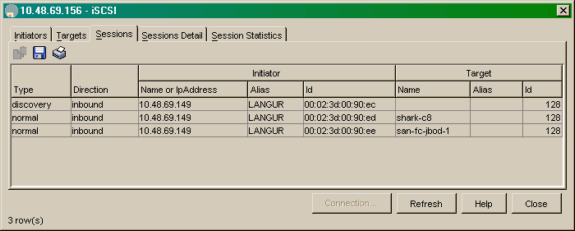
Related Information
Contact Cisco
- Open a Support Case

- (Requires a Cisco Service Contract)
 Feedback
Feedback